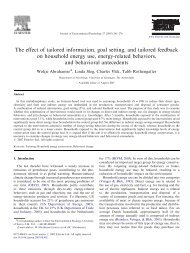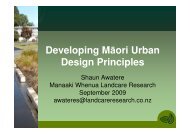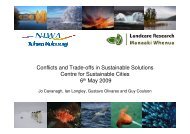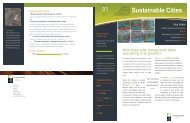Stephen Pattinson: Executive summary of thesis - New Zealand ...
Stephen Pattinson: Executive summary of thesis - New Zealand ...
Stephen Pattinson: Executive summary of thesis - New Zealand ...
You also want an ePaper? Increase the reach of your titles
YUMPU automatically turns print PDFs into web optimized ePapers that Google loves.
5<br />
Attempting a participatory approach, the research investigates four questions:<br />
Question 1:<br />
“What is the nature <strong>of</strong> communal space in existing medium density<br />
housing developments in <strong>New</strong> <strong>Zealand</strong>”<br />
This question explores the views <strong>of</strong> practitioners and current practice regarding<br />
communal space in medium density housing. The writer visited 200 medium density<br />
developments in Auckland, Wellington, Christchurch and Melbourne to observe<br />
first-hand the nature and quality <strong>of</strong> communal spaces. The writer also talked with a<br />
number <strong>of</strong> architects, planners, urban designers, developers, and builders to find<br />
out their viewpoints on communal space in medium density housing.<br />
The finding is that little consideration is given to<br />
communal spaces, and that these spaces tend to<br />
be univalent, i.e. having only one purpose, meaning<br />
or value – usually determined by the designer.<br />
In lower status developments, communal space<br />
tends to be car-dominated, i.e. dedicated to car<br />
parking and manoeuvring (Fig. 3.28).<br />
Fig. 3.28 150 Symonds Street,<br />
Auckland (Photo: S.J.<strong>Pattinson</strong>)<br />
In higher status developments, communal space<br />
tends to be landscape-dominated, for passive<br />
outlook (Fig. 3.36).<br />
Fig. 3.36 The Point – Viaduct<br />
Harbour, Auckland.<br />
(promotional website)<br />
A common viewpoint is that communal space in medium density housing is<br />
primarily for children, however few developments are found to cater for children’s<br />
needs. Furthermore, the <strong>thesis</strong> challenges this conventional viewpoint, asserting<br />
that by making communal space multivalent, it has potential to be rich in meaning<br />
for all age groups, not just for children. This leads to the second research question:<br />
© March 2011 <strong>Stephen</strong> <strong>Pattinson</strong> sjpattinson@paradise.net.nz












